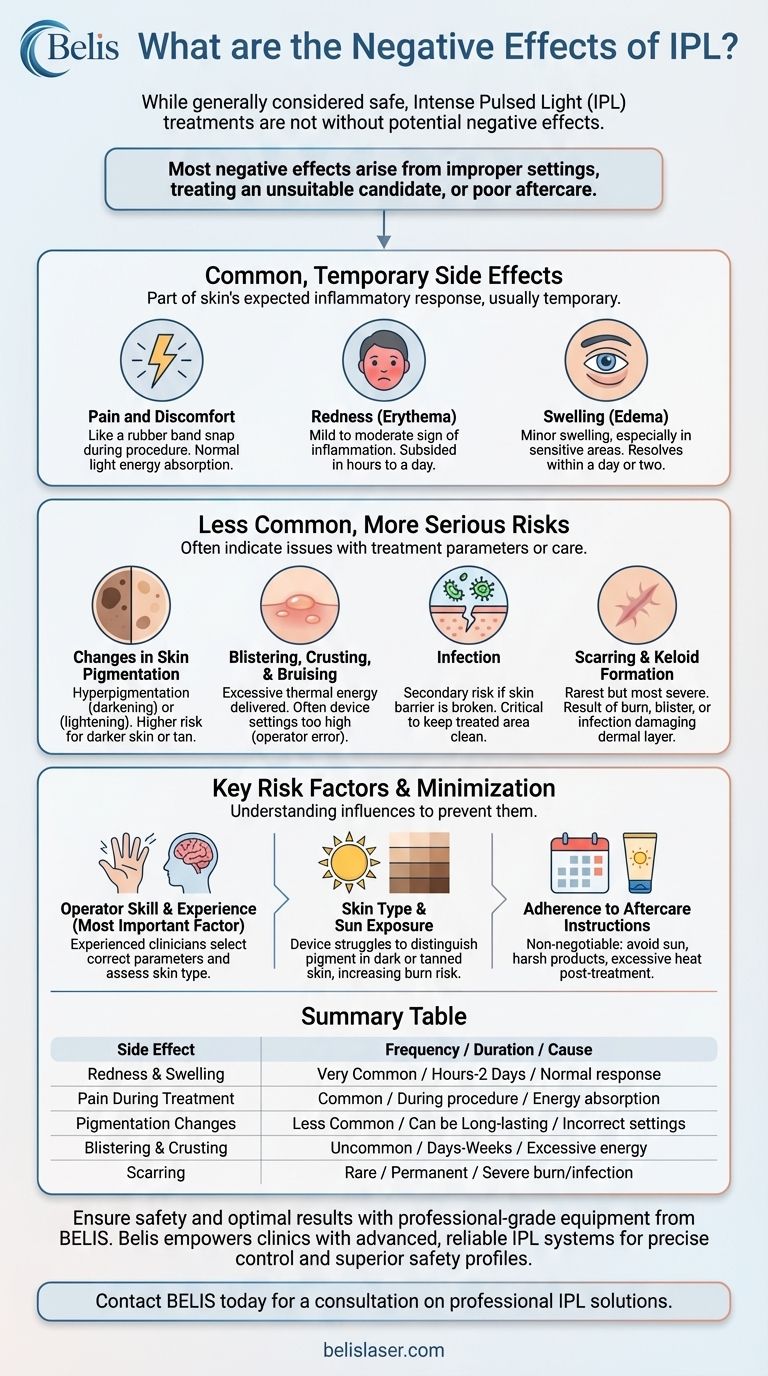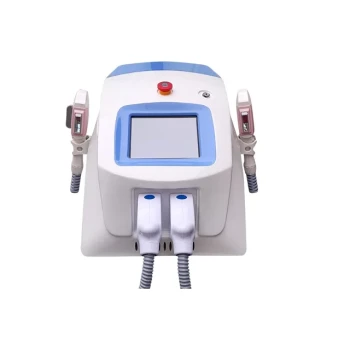While generally considered safe, Intense Pulsed Light (IPL) treatments are not without potential negative effects. The most common side effects are minor and temporary, such as pain during the procedure and redness (erythema) afterward. However, other less frequent but more significant adverse events can occur, including swelling, blistering, changes in skin pigmentation, and, in rare cases, scarring.
The safety and effectiveness of an IPL treatment are less about the technology itself and more about the skill of the operator and the suitability of the patient. Most negative effects arise from improper settings, treating an unsuitable candidate, or poor aftercare.

Breaking Down Common Side Effects
The most frequently reported side effects are typically part of the skin's expected inflammatory response to the light energy. They are almost always temporary.
Pain and Discomfort
During the procedure, most people describe the sensation as a "rubber band snap" against the skin. While uncomfortable, this is a normal and expected part of the treatment as the light energy is absorbed by the target chromophores (like pigment or blood vessels).
Redness (Erythema)
Mild to moderate redness in the treated area is the most common post-treatment effect. This is a sign of inflammation, indicating the skin is responding to the light energy and beginning its healing process. It usually subsides within a few hours to a day.
Swelling (Edema)
Minor swelling, particularly in sensitive areas like under the eyes, can also occur. Like redness, this is a standard inflammatory response that typically resolves within a day or two.
Understanding Less Common but More Serious Risks
These adverse events are significantly less common and often point to an issue with the treatment parameters or the patient's pre- or post-treatment care.
Changes in Skin Pigmentation
This is one of the more significant risks. Hyperpigmentation (darkening of the skin) or hypopigmentation (lightening of the skin) can occur when the light energy is improperly absorbed by the surrounding skin's melanin. This risk is much higher in individuals with darker skin tones or those who have a recent tan.
Blistering, Crusting, and Bruising
The formation of blisters (bullae), crusts, or bruises (hematoma) is a clear sign that the thermal energy delivered to the skin was excessive. This is often the result of the device settings being too high for the patient's skin type, indicating operator error.
Infection
Infection is a secondary risk. It can occur if the skin barrier is broken, for example, by a blister or improper post-treatment care. Keeping the treated area clean is critical to preventing this.
Scarring and Keloid Formation
This is the rarest but most severe potential side effect. Scarring is most likely to occur as a result of a burn, blister, or subsequent infection that damages the skin's dermal layer. Individuals with a personal or family history of keloids are at a higher risk.
Key Factors That Determine Your Risk
Understanding what influences these negative effects is the most important step in preventing them. The risk is not random; it is directly tied to a few critical factors.
Operator Skill and Experience
This is the single most important factor. An experienced technician or clinician knows how to accurately assess your skin type, select the correct device parameters (fluence and pulse duration), and recognize signs of an adverse reaction during treatment.
Your Skin Type and Sun Exposure
IPL works by targeting pigment. If your skin is naturally dark or has a tan, the device has a harder time distinguishing between the pigment in your skin and the pigment in the target (e.g., a sunspot). This dramatically increases the risk of burns and pigmentation changes.
Adherence to Aftercare Instructions
Proper aftercare is non-negotiable. This includes avoiding sun exposure, harsh skincare products, and excessive heat (like saunas or intense exercise) for a specified period after treatment. Failure to do so can turn a minor side effect into a major one.
How to Minimize Risks and Ensure a Safe Treatment
Your proactive involvement in the process is key to a safe and successful outcome.
- If your primary focus is safety: Vet your provider thoroughly. Ask about their certifications, how many IPL treatments they perform, and their experience with your specific skin type and concern.
- If you have a darker skin tone or a recent tan: Insist on a patch test and a consultation with a provider who has extensive, verifiable experience treating skin of color. Be prepared to be told you are not a good candidate at this time.
- If you want to ensure the best possible results: Follow all pre- and post-treatment instructions to the letter, especially regarding sun avoidance and skincare.
By prioritizing a highly skilled practitioner and committing to diligent care, you can confidently manage the potential risks and achieve the desired benefits of IPL.
Summary Table:
| Side Effect | Frequency | Duration | Key Cause |
|---|---|---|---|
| Redness & Swelling | Very Common | Hours to 2 Days | Normal inflammatory response |
| Pain During Treatment | Common | During procedure | Light energy absorption |
| Pigmentation Changes | Less Common | Can be Long-lasting | Incorrect settings for skin tone |
| Blistering & Crusting | Uncommon | Days to Weeks | Excessive energy (operator error) |
| Scarring | Rare | Permanent | Severe burn or infection |
Ensure your clients' safety and achieve optimal results with professional-grade equipment from BELIS.
As a leading provider of medical aesthetic equipment, BELIS empowers clinics and premium salons with advanced, reliable IPL systems designed for precise control and superior safety profiles. Partner with us to enhance your treatment outcomes and build client trust.
Contact BELIS today for a consultation on our professional IPL solutions.
Visual Guide

Related Products
- Clinic Use IPL and SHR Hair Removal Machine with Nd Yag Laser Tattoo Removal
- IPL SHR Hair Removal Machine for Permanent Hair Removal
- IPL SHR+Radio frecuency machine
- Clinic Diode Laser Hair Removal Machine with SHR and Trilaser Technology
- Diode Tri Laser Hair Removal Machine for Clinic Use
People Also Ask
- Are IPL machines safe? Understanding Skin Tone Compatibility for Safe At-Home Use
- Can you see results after 1 IPL? What to Expect from Your First Treatment
- Can I use my IPL machine every week? A Guide to the Optimal At-Home Treatment Schedule
- Is IPL safe on breasts? A Guide to Safe Treatment and Avoiding Risks
- Does IPL work on all hair types? The Truth About Melanin & Hair Removal Success



















